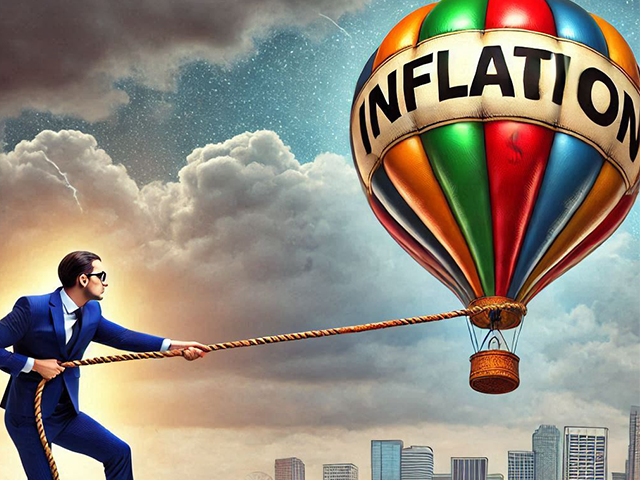Irrational Exuberance Over a Soft-ish Inflation Report
The market appeared to take Wednesday’s report on inflation as an all-clear signal, triggering a rally in bonds and stocks as investors began to recover hope in future rate cuts.
The Department of Labor said the consumer price index (CPI) rose 0.4 percent in December compared with November and is up 2.9 percent compared with a year ago. While that was slightly hotter than expected, core CPI came in cooler than expected, rising just 0.2 percent month-over-month. That lowered the year-over-year rate to 3.2 percent from 3.3 percent, slightly better than what was expected.
That was the softest reading for core CPI since July. Analysts had penciled in a 0.3 percent increase, which would have been unchanged since the previous month. Note, however, that the unrounded month-over-month figure of 0.23 percent was just a smidge away from rounding up to the expected figure. Still, the decline represents a significant move in the right direction for core inflation.
Most of the decline came from core goods excluding used cars and trucks. Sliced this way, goods prices fell 0.1 percent. That’s a return to the modest deflationary trend that we saw until the surprise return of core-core goods inflation in November. It likely reflects softer export demand as well as some selling off of inventories that might have been built up in anticipation that port worker strike would last longer than it did.
We think that prices of core goods are unlikely to keep falling, which will mean that future inflation reports will not have the benefit of deflationary pressure on the goods side. That could mean higher inflation later this year if services prices continue to climb.
No Sign of Tariff Price Pressure
One thing to note is that this suggests that reports of the threat of Trump tariffs already pushing up prices is baseless. There are no signs of pre-emptive price increases, which aligns with our expectation that businesses will resist passing on taxes on imports in order to stay competitive and not drive away customers. While some analysts argue that recent experience with high inflation would make it easier for businesses to raise prices, we think the opposite is true. Consumers are angry about high prices and likely to turn against merchants driving prices higher.
It’s important to remember that Bidenflation was not driven primarily by increased costs. Instead, it was driven by excess demand and supply constraints. This is one reason why inflation was so good for the bottom line of many companies, fueling complaints from progressive politicians about price gouging and reducing real wages. Tariffs may increase costs for some importers, but this will not necessarily give them the ability to raise prices.
Food, Energy, Shelter Prices Still Rising
The politically sensitive non-core consumer goods are still seeing rising prices. Food prices increased 0.3 percent in December. That followed a 0.4 percent increase in November. The index for cereals and bakery products jumped 1.2 percent, reversing the November decline. Meats, poultry, fish, and eggs increased 0.6 percent, boosted by 3.2 percent rise in egg prices.
Over the last year, food at home prices are up 1.8 percent, which does not seem that bad. But keep in mind that this is on top of the massive increases in the two years prior, increases which still have many consumers feeling squeezed. The meats, poultry, fish, and eggs index—so, core proteins—rose 4.2 percent over the last year. Ground beef prices are up 5.2 percent and egg prices are up 36.8 percent.
Gasoline prices jumped 4.4 percent for the month and piped natural gas rose 2.4 percent. The increase in electricity was milder at 0.3 percent.
Housing continues to add to inflation, with residential rent rising 0.3 percent for the month and 4.3 percent from a year ago. We’ve been hearing for years now that this is a lagging inflationary indicator and bound to come down any month now. At this point, that narrative is far past its due date. In any case, analysts appear to have this backward, thinking that less shelter inflation would lead to less inflation overall. To the contrary, housing costs are likely eating up demand that would be pushing other prices higher. That’s one reason we think it is incredibly foolish to “look through” shelter inflation if you are trying to determine underlying inflationary pressures.
Underlying Inflation Strong Enough to Kill Off Any More Fed Cuts
Our favorite indicators of underlying inflation are the median CPI and 16 percent trimmed mean CPI, which are both calculated by the Cleveland Fed. Median CPI rose 0.3 percent, which it has done in every month but one since July. Trimmed mean CPI also rose 0.3 percent, which it has done in every month since September. We take this as a signal that inflation has become embedded at a high level and is unlikely to meaningfully decline in the months ahead.
The market’s reaction seems overdone. The swaps-implied odds of a second cut this year increased dramatically, while stock and bonds rallied. Some of this might be relief. If inflation had come in worse than expected, the odds of a Fed hike this year would have increased. As it is, this number is consistent with no more cuts—not the one or two the market now expects. That means both stock and bond prices will face repricing risk if the market loses confidence that those cuts are coming.
In short, the December CPI report is a sign that the Fed’s fight against inflation has stalled. When the market realizes this, bond yields are likely to climb and stock prices likely to fall. But it may take a few more reports for the message to get through.

COMMENTS
Please let us know if you're having issues with commenting.